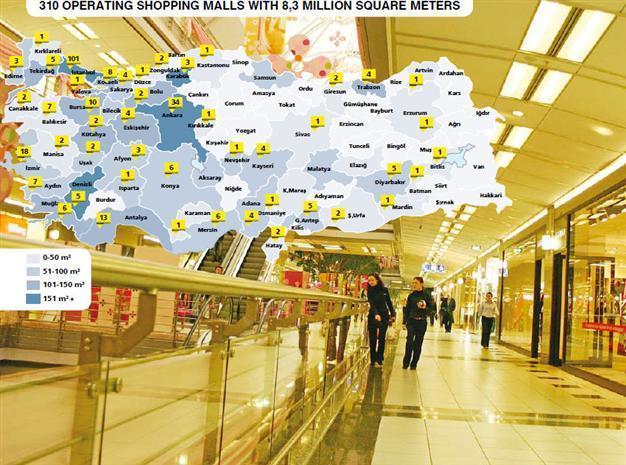Malls in Turkey still take small share of overall spending
MUSTAFA SÖNMEZ

The sales made at Turkish shopping malls amounted $28 billion in 2012, at around 7 percent of total household spending for 2012 which was $580 billion, according to the data from the Association of Shopping Mall Investors. Small retailers have long been objecting to the construction of malls in city centers, citing unfair competetion, and demanding that they be restricted to suburban areas. DAILY NEWS photo, Hasan ALTINIŞIK
The number of shopping malls in Turkey has reached 310 with the ones recently established. However, the share of these malls constitutes only 7 percent of our overall shopping spending. Some 101 of these malls are located in Istanbul, corresponding to about 40 percent of the total area occupied by malls.Shopping malls, which have lately become one of the top agenda topics due to the Gezi Park protests, could be regarded as a new phenomenon in the Turkish context. Nevertheless, a lot of land is allocated to them. While major capital groups have a tendency for shopping malls, both as managers and investors, foreign investors are also attracted by them. Malls particularly concern urban people, consumers and small retailers, as they create problems in the distribution of urban land. So, let’s have a look at how this trend emerged.
A result of neoliberalism
Each regime of capital accumulation has its own form of urban space and shopping style. The Keynesian accumulation regime before 1980 did not resemble the one experienced with the globalization process, being relatively more introverted. Varieties in commodities and brands were not particularly high. Profits were mainly made in industry, while retail was mostly the job of smaller entrepreneurs. Major retailers were still there, but they were not the global focus of great capital groups yet.
By 1980, the capital accumulation was trying to create new spaces for itself, finally turning its eyes on the space of small entrepreneurs. In time, the profits that could be made from urban areas such as Istanbul became more attractive than profits obtained from industry. So, an era of demolishing traditional shopping places and styles, and engaging in large-scale retailing activities began. The retail trade, which used to take place at bazaars and smaller stores, is now typically conducted in large shopping malls. Thus, the traditional structures of cities are being harmed. Many skyscrapers with shopping malls on the ground floors are being built in irrelevant places, only to gain profits.
You can see all the great capital groups among the shopping mall investors - all the major banks and holdings you can think of, keen to rush and swarm around wherever the money is. So, these investors have gathered together under the roof of the “Association of Shopping Mall Investors”
Market share?
According to announcements, sales made at Turkish shopping malls amounted to $28 billion in 2012. Total household spending for 2012 was $580 billion. If we exclude some spending categories such as housing, transportat, education and health, we reach about $385 billion of consumption expenditure, with many small and major retailers benefiting from this.
 The total number of shopping malls in Turkey reached 310 with the ones established in recent years. However, the shopping in these malls still constitutes only 7 percent of our total spending. Even though this is not yet an alarming rate, it would be right to draw attention to the short term improvement tendencies. Many shopping mall investments cannot find what they expected, but major domestic and foreign investors interpret this result as meaning that there are still many things to be done for malls.
The total number of shopping malls in Turkey reached 310 with the ones established in recent years. However, the shopping in these malls still constitutes only 7 percent of our total spending. Even though this is not yet an alarming rate, it would be right to draw attention to the short term improvement tendencies. Many shopping mall investments cannot find what they expected, but major domestic and foreign investors interpret this result as meaning that there are still many things to be done for malls.As in the case at Gezi Park protests, people are concerned about the fact that shopping malls are built on sold off public land such as parks and green areas, spoiling the traditional structure of cities. These concerns lead to conflicts with both local and central administrative units of government. This sensitivity of urban people makes all kinds of small retailers believe that the malls cause unfair competition. As a result they object to the malls and demand that they are built in suburban areas instead of downtown and traditional residential areas.
The interest shown in malls not only stems from the shopping activity itself. Renowned French philosopher Jean Baudrillard calls such places the “new public sphere,” describing them as follows: “A surreal space that brings together the components that do not have any relation with each other both semantically and spatially such as entertainment agents like carousels and ice-skating rinks, technological aspects such as panoramic elevators and moving stairways, and architectural features such as arches, domes, and bridges.”
Besides, another subject requiring analysis is why the masses gathering in these malls, or “surreal spaces,” choose to breathe the air of these “contemporary fairs,” despite the nice and sunny weather outside.
















